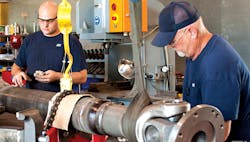How to leverage apprenticeship programs in the manufacturing industry
In this article:
For many years, high school students had four basic choices upon graduation: attend college, attend trade school, enter the military, or take an unskilled position and work their way up an organization through hard work and dedication. Unfortunately, the ones who chose the last option were affected by declining, unskilled U.S. manufacturing jobs over the decades, beginning with the increased use of industrial machinery that would work more efficiently than their human counterparts. In contrast, skilled jobs saw a dramatic increase due to the very machines used to replace unskilled workers. Companies needed highly skilled machinists, millwrights, industrial electricians, and many other specialists to install and maintain the new equipment hitting the production floor. Technically minded people could find stable, high-wage positions at many manufacturers across the country.
However, in the early nineties, this shift toward skilled trades took a drastic turn for manufacturers with the explosion of IT positions created by the growing use of computers in the workplace. Many technically astute high school graduates were lured away from physically demanding skilled trade positions by the rapid rise in demand for IT positions that paid well and provided air-conditioned working environments on corporate campuses.
To make matters worse, universities, community colleges, and trade schools quickly pivoted their scarce resources toward developing programs to graduate as many programmers, software developers, and hardware technicians as possible to keep up with the demands of corporate America. The graying of the skilled trades arena quickly accelerated by the late nineties.
Fortunately, there is a way for employers in need of employees to fill their ever-important skilled trade positions, but the solution requires dedication, patience, and resources. For those employers with those attributes, apprenticeships could prove to be the answer to their hiring woes.
Solutions through apprenticeship programs
Apprenticeship programs have been around for hundreds of years across the globe and followed similar paths of development over time. In ancient Babylon, the Code of Hammurabi required artisans to teach their craft to the next generation. During the Roman Empire, artisans began to coalesce into organizations called collegia, whose purpose was to maintain standards of work and quality. In western Europe, craft guilds began to form around skilled trades. One of the key aspects of each of these methodologies was to develop the next generation of skilled workers.
You may be asking yourself, “What is an apprenticeship program?” Apprenticeships generally center on a specific industry or type of trade. Employers develop the programs to train a pipeline of candidates and prepare them for an immediate job upon completion. An apprenticeship is usually multi-year and combines paid on-the-job training in real-world situations, classroom instruction by knowledgeable professionals, mentorship by existing employees in the same trade, and, in many cases, comes with a credential or certification that employers across the country recognize.
Apprenticeship programs establish a pipeline of candidates for future positions that the employer can develop and monitor overtime to greatly increase the chance of recruiting a highly engaged, long-term employee. These programs also benefit employers in many other ways:
- Good forecasting of future job needs allows an employer to load the pipeline with enough students to guarantee that critical skill gaps do not occur.
- Program graduates improve company profitability due to higher productivity levels, as they are given the exact skills needed by the employer.
- Turnover is reduced because graduates feel loyalty to their employers for investing in them through the program. Some studies show as many as 94% of graduates continue their employment at apprenticeship program completion.
- Apprenticeship programs tend to bring in assorted candidates, which helps create diversity of thought in the workplace.
Figure 1. Apprenticeships include mentoring by existing employees in the same trade. (Source: Motion)
Developing a program
Fortunately, modern employers can implement their own apprenticeship programs without guilds or collegia. Still, a partnership with a trade school, community college, industry organization, or the federal government will prove essential in successful program development.
There are two primary types of apprenticeship programs in the U.S.: Registered Apprenticeship Programs (RAP) and Industry-Recognized Apprenticeship Programs (IRAP). A RAP is a proven apprenticeship model approved by the Department of Labor (DOL) or a state apprenticeship agency. IRAPs are recognized as high quality by a Standards Recognition Entity (SRE) pursuant to the DOL’s standards.
Next steps forward: New skills and careers for veterans
Proactive leadership: Crisis-ready organizations need strong foundations
3 tips to improve your leadership skills
Possibly the most important key to an apprenticeship program’s success is selecting the correct partner with which to create, develop, and administer the program. Industry organizations can help determine the core attributes of a specific trade that are common across most, if not all, employers in a specific industry. Once the core attributes are established, an employer may partner with a community college or local trade school to review how to deliver the classroom portion of the program. These institutions have the expertise to match core curriculums with the attributes established by the industry organization.
Employers can then weave in real-world, on-the-job training, driving home what the students learn and providing the hands-on skills needed in the workplace that are not necessarily achievable in a school setting (see Figure 1). By partnering with industry organizations, local community colleges, and trade schools, employers do not have to overload their own learning and development departments with a program they may not have the capacity to properly develop. By dividing and conquering the important steps along the way with trusted partners, the program has a high chance of being impactful, engaging, and rewarding for everyone involved.
Win-win
A well-thought-out and executed apprenticeship program is truly one of those rare win-win situations. For interested workers, these programs offer a viable trade and immediate job opportunities upon graduation that offer high wages and good benefits (see Figure 2). For employers, these programs offer the chance to develop a predictable talent pipeline that will satisfy essential, hard-to-fill positions for years to come. What is not to like about any of these outcomes? So, get started and grow the next generation of skilled tradespeople who will turn your company into a talent juggernaut.
This story originally appeared in the September 2021 issue of Plant Services. Subscribe to Plant Services here.



